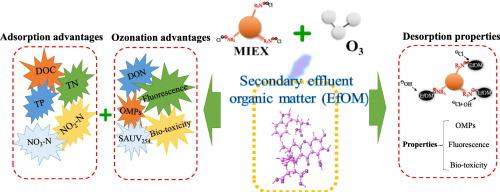Science of the Total Environment ( IF 9.8 ) Pub Date : 2020-09-14 , DOI: 10.1016/j.scitotenv.2020.142361 Yingcai Tang , Zhiqiang Chen , Qinxue Wen , Boxuan Yang , Yang Pan

|
The presence of effluent organic matter (EfOM) and organic micro-pollutants (OMPs) in secondary effluent is receiving increasing concern due to their potential impacts on the aquatic environment and human health. In this study, the removal characteristics of EfOM by magnetic ion-exchange resin (MIEX), ozonation, and the hybrid process of MIEX followed by ozonation (M + O) were compared by measuring the bulk organic indicators (BOIs), OMPs, bio-toxicity, and fluorescence. Furthermore, the desorption characteristics of MIEX were comprehensively studied. Ozonation could reduce the OMPs, total fluorescence (TF), genotoxicity, and oestrogenic activity more effectively than MIEX, with reductions of 80.3%, 97.8%, 98.9%, and 94.6%, respectively. The M + O process was capable of removing more EfOM than the individual MIEX or ozonation processes and could reduce the genotoxicity and oestrogenic activity to the detection limit. By implementing MIEX as a pre-treatment, the generation of ammonia–nitrogen and nitrate–nitrogen was effectively reduced in the subsequent ozonation process as MIEX adsorbed organic nitrogen and nitrite-nitrogen. The different regenerants influenced the OMP desorption performance of MIEX by changing the desorption mechanisms, and NaCl + NaOH was the best regenerant due to its high total OMP desorption efficiency. Parallel factor analysis coupled with self-organising maps further explained the differences in fluorescence desorption due to the addition of NaOH to the regenerated solution. Pearson correlation analysis indicated the potential of using spectroscopic indicators, such as ultraviolet absorbance and TF, to assess the evolution of OMPs and bio-toxicity during the M + O and MIEX desorption processes.
中文翻译:

磁性离子交换树脂处理然后臭氧化处理次级废水有机物的混合工艺的评估
次级废水中存在废水有机物(EfOM)和有机微污染物(OMPs),这对它们对水生环境和人类健康的潜在影响正日益引起人们的关注。在这项研究中,通过测量大体积有机指示剂(BOIs),OMPs,生物素,比较了磁性离子交换树脂(MIEX),臭氧化和MIEX混合后臭氧化(M + O)的EfOM去除特性。 -毒性和荧光。此外,还对MIEX的解吸特性进行了综合研究。与MIEX相比,臭氧化处理可以更有效地降低OMP,总荧光(TF),基因毒性和雌激素活性,分别降低80.3%,97.8%,98.9%和94.6%。与单独的MIEX或臭氧化过程相比,M + O过程能够去除更多的EfOM,并且可以将遗传毒性和雌激素活性降低至检测极限。通过实施MIEX预处理,由于MIEX吸附了有机氮和亚硝酸盐氮,因此在随后的臭氧化过程中有效减少了氨氮和硝酸盐氮的产生。不同的再生剂通过改变脱附机理影响MIEX的OMP脱附性能,而NaCl + NaOH由于其高的OMP脱附效率而成为最好的再生剂。平行因素分析与自组织图结合进一步解释了由于在再生溶液中添加NaOH而导致的荧光解吸差异。



























 京公网安备 11010802027423号
京公网安备 11010802027423号